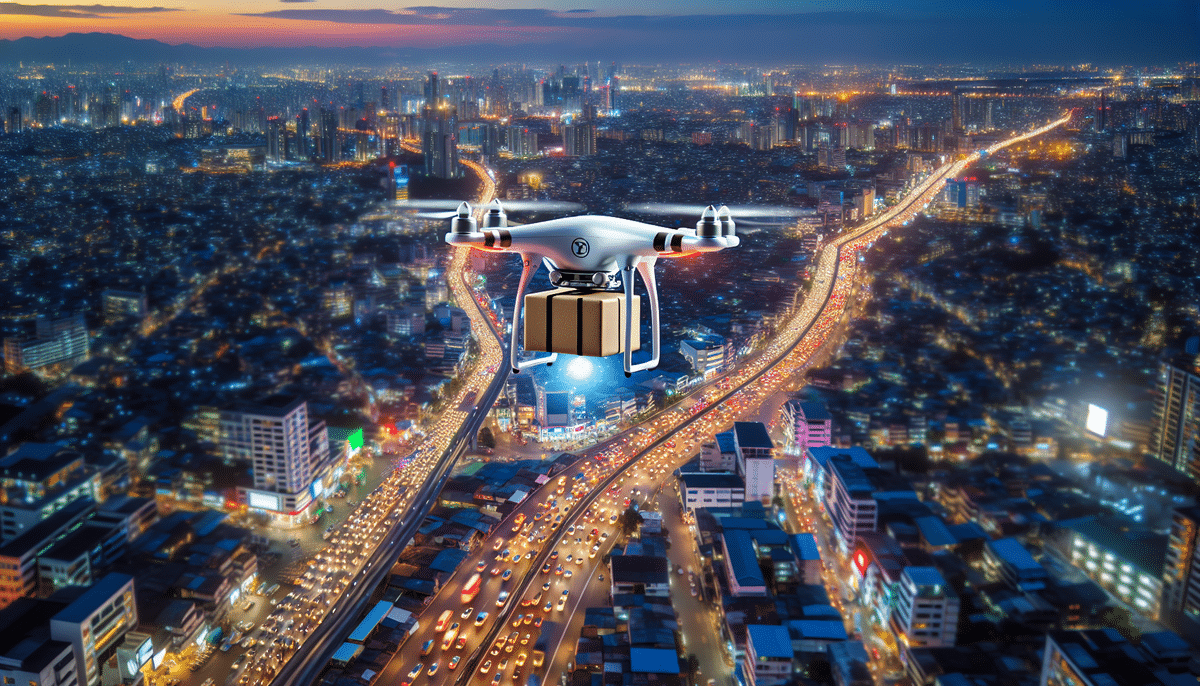Enhancing Delivery Speed in E-Commerce Logistics
In today's fast-paced market, delivery speed is a critical factor that can determine the success or failure of an e-commerce business. Customers expect their orders to arrive quickly, and with numerous options available, they are quick to switch to competitors if their delivery expectations are not met. This article delves into the significance of fast delivery in e-commerce, examines the current challenges faced by logistics providers, and outlines effective strategies for streamlining delivery processes to enhance speed and efficiency.
The Critical Role of Fast Delivery in E-Commerce
Fast delivery is indispensable for e-commerce businesses striving to stay competitive. Leading companies like Amazon have set high standards by offering same-day and even two-hour delivery in select areas, setting customer expectations for near-instant gratification. Quick delivery not only boosts customer satisfaction and encourages repeat business but also:
- Increases revenue: Faster delivery options can encourage higher spending per order.
- Enhances competitive edge: Businesses that deliver quickly stand out in a crowded market.
- Boosts customer loyalty: Reliable and fast delivery fosters trust and long-term relationships.
According to a Statista report, 69% of online shoppers expect delivery within two days, highlighting the importance of meeting these expectations. Additionally, optimizing delivery routes and reducing transit times can lower a company’s carbon footprint, contributing to sustainability—a growing concern among consumers.
Current Challenges in E-Commerce Logistics
Achieving fast delivery in e-commerce logistics involves overcoming several challenges:
- Rising demand: The surge in online orders strains existing infrastructure and resources.
- Last-mile delivery complexities: The final leg of delivery is often the most costly and time-consuming.
- Package security: Ensuring the safety of packages during transit is paramount, especially with increasing instances of theft and damage.
- Technology integration: Optimizing delivery routes and processes requires advanced technology and data analytics.
Addressing these challenges is essential for logistics providers to meet the growing expectations for fast and reliable delivery. For instance, the PwC Consumer Intelligence Series emphasizes the need for seamless logistics to enhance customer experience.
Effective Strategies to Streamline Delivery Processes
To improve delivery speed and efficiency, e-commerce businesses can implement several strategies:
- Automated sorting and picking systems: Automation can handle large order volumes efficiently, reducing processing time.
- Drone and autonomous vehicle delivery: These technologies expedite last-mile delivery while lowering operational costs.
- Partnering with local delivery services: Collaborations leverage existing networks to shorten delivery times.
- Utilizing strategically placed fulfillment centers: Proximity to customers reduces shipping distances and transit times.
- Offering flexible delivery options: Options like same-day or next-day delivery, along with real-time package tracking, enhance the customer experience.
Implementing these strategies can significantly optimize delivery processes, ensuring faster and more efficient order fulfillment.
Automated Sorting and Picking Systems
Implementing automated systems in warehouses can drastically reduce the time required to sort and pick orders. According to a The Balance Small Business report, automation can increase warehouse productivity by up to 25%, leading to quicker delivery times.
Drone and Autonomous Vehicle Delivery
Innovations like drones and autonomous vehicles offer promising solutions for last-mile delivery challenges. Companies like Alibaba have successfully implemented drone deliveries in remote areas, showcasing the potential for widespread adoption.
Innovative Technologies Enhancing Delivery Speed
Technological advancements are transforming the logistics industry, providing new avenues to enhance delivery speed:
- Blockchain technology: Ensures a secure and transparent supply chain, enhancing traceability and reducing fraud.
- Internet of Things (IoT) devices: Enable real-time tracking and monitoring of packages, improving visibility and accountability.
- Machine learning and artificial intelligence: Optimize delivery routes and predict demand patterns to enhance efficiency.
- Autonomous vehicles and drones: Offer faster and more efficient deliveries by bypassing traffic and navigating challenging terrains.
While these technologies offer significant benefits, challenges such as regulatory hurdles and safety concerns need to be addressed for their widespread adoption. A McKinsey report highlights the importance of addressing these challenges to fully leverage technological advancements in logistics.
Automation and Robotics in E-Commerce Logistics
Automation and robotics are becoming integral to e-commerce logistics, offering numerous advantages:
- Automated warehouses: Reduce the time required to pick and pack orders, enhancing order processing speed.
- Robotic delivery systems: Automate last-mile delivery, reducing delivery times and operational costs.
- Cost reduction: Automation minimizes the need for human labor, lowering labor costs and increasing efficiency.
- Optimized delivery routes: Robots can be programmed to determine the most efficient delivery paths, cutting transportation costs.
However, businesses must consider the initial investment, ongoing maintenance costs, and potential job displacement when integrating automation and robotics into their logistics operations.
Enhancing Last-Mile Delivery Efficiency
Last-mile delivery remains one of the most challenging and expensive aspects of e-commerce logistics. To enhance efficiency and speed, businesses can:
- Utilize crowdsourced delivery models: Leverage independent contractors to expand delivery networks flexibly.
- Implement locker systems: Provide customers with secure locations for package pickups, reducing delivery attempts.
- Offer flexible delivery options: Evening or weekend deliveries can accommodate diverse customer schedules.
- Use route optimization software: Helps delivery drivers plan the most efficient routes, considering traffic, road closures, and delivery windows.
Optimizing last-mile delivery not only reduces delivery times and costs but also significantly improves customer satisfaction. According to a Forbes article, implementing these strategies can lead to up to a 30% reduction in last-mile delivery costs.
Optimizing Supply Chain Management for Quick Delivery
Effective supply chain management is pivotal for ensuring rapid delivery in e-commerce. Key practices include:
- Efficient inventory management: Ensures products are readily available for order fulfillment.
- Data analytics for demand forecasting: Predicts customer demand patterns to streamline ordering processes.
- Strong supplier and logistics provider relationships: Facilitates smooth operations and timely deliveries.
- Understanding customer preferences: Analyzing purchasing behavior helps in making informed inventory and product offering decisions.
By optimizing the supply chain, businesses can reduce the time products take to move from manufacturers to customers, thereby enhancing overall delivery speed. A study by the Supply Chain Digital highlights that integrated supply chain systems can improve delivery times by up to 20%.
The Impact of Effective Inventory Management on Delivery Speeds
Inventory management directly affects delivery speed and efficiency in e-commerce logistics. Effective practices include:
- Advanced inventory management software: Facilitates real-time tracking and management of inventory levels.
- Efficient warehouse management: Streamlines order fulfillment processes.
- Demand forecasting: Predicts future product demand, preventing stockouts and overstocking.
Maintaining optimal inventory levels ensures that orders are fulfilled promptly, reducing delivery times and enhancing customer satisfaction. According to Investopedia, effective inventory management can decrease order-to-delivery time by up to 15%.
Leveraging Big Data Analytics to Improve Shipping Performance
Big data analytics provides valuable insights into the e-commerce logistics process, enabling businesses to:
- Identify bottlenecks and inefficiencies: Pinpoints areas that need improvement in the shipping process.
- Optimize delivery routes and schedules: Enhances efficiency and reduces transit times.
- Enhance overall delivery speed: Uses data-driven strategies to streamline logistics operations.
By leveraging big data, businesses can make informed decisions that improve shipping performance and accelerate delivery times. A Business.com article notes that companies utilizing big data analytics can see up to a 10-15% improvement in delivery efficiency.
Best Practices for Managing Returns and Exchanges
Returns and exchanges present significant challenges for e-commerce businesses, potentially impacting delivery speed and incurring additional costs. To manage these effectively, businesses should:
- Implement flexible return options: Allow customers to choose convenient return methods.
- Streamline the returns process: Simplify procedures to handle returns efficiently.
- Use data analytics: Identify trends in returns to minimize their occurrence.
Effective management of returns and exchanges ensures that they do not disrupt primary delivery operations, maintaining overall delivery speed and customer satisfaction. According to Forbes, efficient returns management can improve customer retention rates by up to 14%.
Addressing Environmental Concerns in E-Commerce Logistics
E-commerce logistics has a significant environmental impact, particularly concerning carbon emissions and waste. To mitigate these effects, businesses can:
- Adopt eco-friendly delivery options: Utilize electric vehicles or bike couriers to reduce emissions.
- Reduce packaging waste: Minimize the use of plastics and opt for recyclable materials.
- Optimize delivery routes: Use data analytics to decrease the number of miles traveled, lowering fuel consumption.
By implementing these environmentally conscious strategies, e-commerce businesses can contribute to sustainability while maintaining efficient logistics operations. The United Nations Sustainable Development Goals emphasize the importance of sustainable practices in reducing environmental impact.
The Future of Rapid Delivery in E-Commerce
The demand for rapid delivery continues to rise, and e-commerce businesses must innovate to meet evolving customer expectations. Future trends in e-commerce logistics are likely to include:
- Advancements in automation and robotics: Further integration of automated systems to speed up order processing and delivery.
- Emerging technologies: Increased use of AI and blockchain to enhance transparency and efficiency.
- Enhanced last-mile delivery: Continued focus on optimizing last-mile processes through technology and strategic partnerships.
Staying ahead in the fast-paced e-commerce landscape requires continuous adaptation and investment in cutting-edge logistics solutions. According to a Forbes article, technologies like AI and machine learning will play pivotal roles in shaping the future of logistics, enabling even faster and more reliable delivery services.
Case Studies: Successful Implementation of Faster Delivery Models
Several e-commerce businesses have successfully implemented faster delivery models, achieving significant improvements in delivery speed and efficiency:
- Amazon Prime: Through extensive investments in logistics infrastructure and technology, Amazon has reduced delivery times, offering benefits like same-day shipping.
- Zappos: Known for its exceptional customer service, Zappos offers free and fast shipping as a core component of its value proposition.
- Warby Parker: Differentiates itself by providing swift delivery options, enhancing the overall customer experience.
These examples demonstrate the tangible benefits of investing in delivery speed enhancements and the positive impact on customer satisfaction and business growth. For instance, Amazon Prime members are shown to spend more and exhibit higher loyalty compared to non-members, as reported by a Business Insider study.
Measuring Success: Metrics and KPIs for Tracking Delivery Speeds
To improve delivery speed, businesses must effectively measure their performance and track progress over time. Key performance indicators (KPIs) include:
- Order-to-delivery time: The total time taken from order placement to delivery.
- On-time delivery rate: The percentage of orders delivered within the promised timeframe.
- Delivery cost per order: The average cost associated with delivering each order.
- Customer satisfaction scores: Metrics derived from customer feedback regarding their delivery experience.
By monitoring these metrics, e-commerce businesses can identify areas for improvement, optimize their delivery processes, and ensure they consistently meet customer expectations for speed and reliability. A Investopedia overview suggests that regularly tracking these KPIs can lead to a 5-10% improvement in delivery efficiency over time.
In conclusion, enhancing delivery speed in e-commerce logistics is vital for businesses aiming to stay competitive and meet customer expectations. By understanding current challenges, leveraging innovative technologies, and implementing best practices in supply chain management and last-mile delivery, businesses can significantly improve delivery speed and efficiency, ultimately elevating the overall customer experience.








